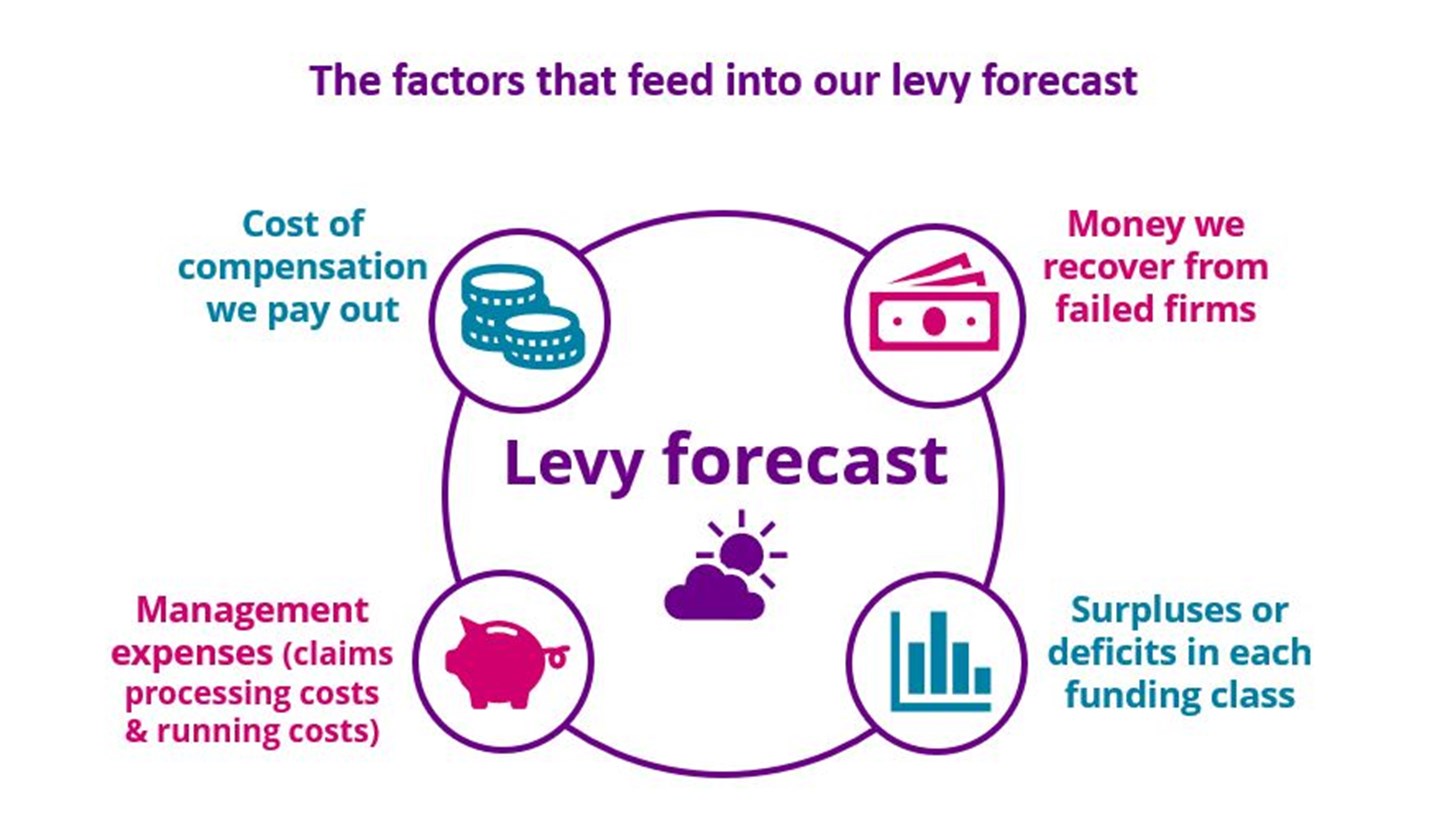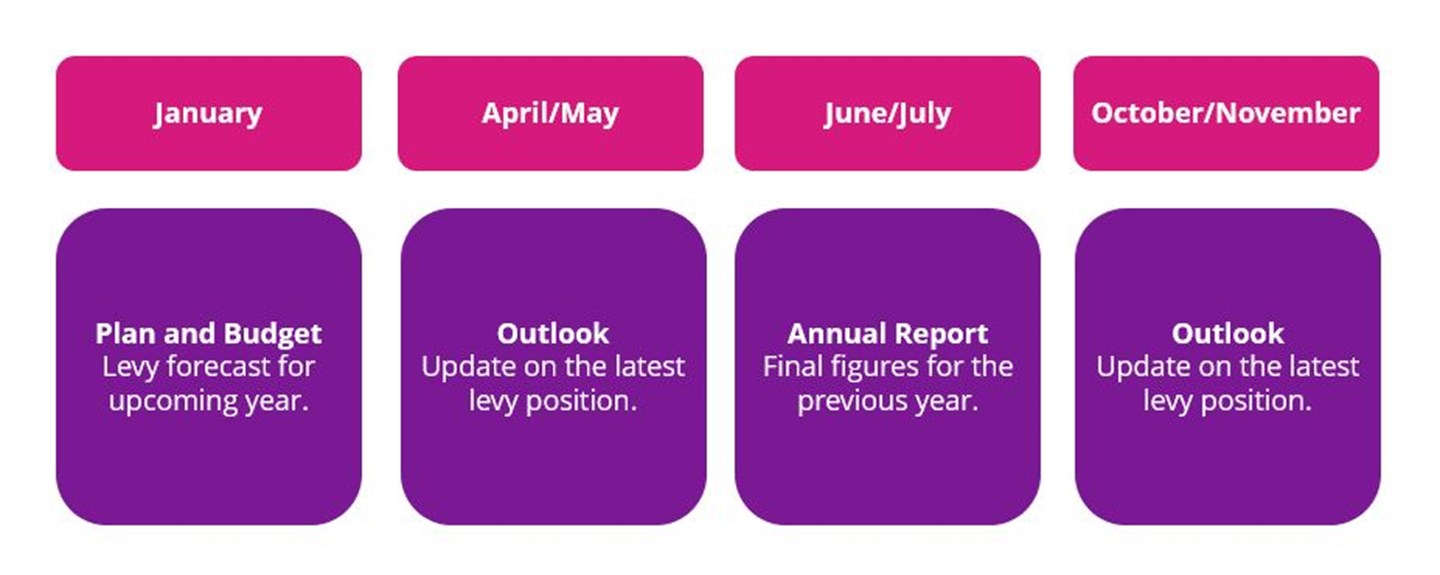
How we forecast the levy
Forecasting the cost of our annual levy is a complex task with many moving parts. Our Chief Financial Officer, Fiona Kidy, reveals all about our forecasting process and explains why the final levy can end up being quite different to our first forecast.
We offer our customers a completely free service thanks to an annual levy that authorised financial services firms pay us. The levy funds the cost of the compensation we pay our customers, as well as the costs of running our service and processing claims.
How we go about forecasting the levy – especially the compensation costs element – has often been thought of as a bit of a mystery. I want to bring to light the entire process to make it completely transparent and explain why the final levy can end up being quite different to our first forecast, despite our rigorous monthly forecasting process.
The levy forecast is a prediction of the cash we need to process claims and pay the compensation costs for the year in question. Our forecast contains four main elements, which we review for each funding class: compensation costs, management expenses, recoveries and class surpluses or deficits. I’ll talk more about each of these below.

Compensation costs
How much compensation we think we’ll need to pay out each year is a crucial part of our forecasting. We need to anticipate how many claims we expect to receive and the projected value of these claims. We begin by looking at the firms that have recently failed and the number of claims we’re still receiving against them.
We then carry out a horizon scanning exercise of the firms that could fail and the related claims volumes and values we think we’ll see. Here we work closely with the Financial Conduct Authority (FCA), Prudential Regulation Authority (PRA), Financial Ombudsman Service, MoneyHelper and the wider industry so we can include information from their watchlists and monitor any trends.

It’s key to make sure our predictions are aligned with our regulatory partners but this isn’t an easy task with so many moving parts. There are a number of variables we need to predict here, including if and when each firm may fail and when we might start to receive claims. Our knowledge of the firms and our resulting predictions are reliant on the quality of data available to us, which does vary, making it even harder to predict accurately.
We then need to forecast the number of customers and their eligibility to claim with us, the types of financial products the firms sold and the funding class they sit in. We assess the potential cost of each of those claims, according to our rules, historical payment levels and compensation limits. As you can imagine, due to the number of assumptions we have to make, there’s a lot of uncertainty in this part of the process.
We review our assumptions every month and they do change across the year, especially as we learn more about the firms that have just failed, the potential claims they may generate and the actual number of claims we end up receiving, or if an unforeseen event occurs.
Management expenses
We use the same claims assumptions that informed our compensation costs forecast to build our management expenses budget – as this includes the costs of processing claims and making compensation payments. It also includes our fixed running costs, like our rent and business rates (the business equivalent of council tax), which don’t relate to paying compensation.
Behind the scenes, we refine our management expenses calculations every month, and we update the industry twice a year: in January’s Plan and Budget to announce the management expenses budget for the year and October’s Outlook to give the latest forecast. Our Annual Report in the summer then provides the actual numbers for the year. If the amount we spend on management expenses is different to what we levied, then we true up in the following year by adjusting that year’s levy.
Recoveries
Whenever possible and if it’s cost-effective, we seek to recover the money we’ve paid in compensation from failed firms and third parties. It’s a crucial part of our strategy to bring down levy costs and we’ve recovered more than £280m since the start of the 2015/16 financial year.
Recoveries play a key role in the final levy calculation but it’s incredibly difficult to predict how much we’ll recover each year. Some of our bigger recoveries can take many years to wrap up and in these cases, we won’t know which financial year the money will fall into until we receive it. An extreme example is our recovery of £20bn of the £20.9bn we paid in compensation as a result of the 2008 banking crisis. We didn’t receive the final recovery payment until 2020, 12 years later.
We do forecast which recoveries we are very likely to receive in that year and use these amounts to offset the levy. I say ‘very likely’ because recoveries are volatile and difficult to predict, and we only include those that we can be fairly certain of. If we then receive further recoveries on top of those included in the levy, they may generate a surplus, as I explain in the next section.
Class surpluses or deficits
The levy is calculated based on the cash that we expect to pay out in a year – we don’t aim to hold extra funds. However, the reality is that the amount we actually pay out, or recover, can be different to what we originally expected and levied for each year. This variance creates a surplus or deficit in our levy funds.
We constantly monitor our projected year-end surplus or deficit and we look at it on a class-by-class basis. If the deficit for an individual class is significant (normally £20m or more) then we look to raise a supplementary levy on that class. We do this even when there are surpluses in other classes because those surpluses were paid for by other, unrelated firms. We keep each class separate because different firms pay into them so shouldn’t cover another class’s shortfall (apart from when the retail pool is triggered – but that’s a story for another day!)
We usually communicate our need for a supplementary levy in our October edition of Outlook, then confirm the revised number in January’s Plan and Budget. However, in the rare event that we need the funds at short notice, for example, if there is an unexpected deposit-taker failure, we would announce this in a separate press release.
If we expect a surplus, then we normally use it to offset the following year’s levy for the class in question. But if, based on our latest forecast, we don’t expect that class to use the surplus in the near future then we would refund firms that year. As I said before, it’s not our intention to hold surplus funds.
Keeping the industry updated
As you can see, we have to look at the levy from many different angles, and there's uncertainty at every stage. We know how important it is to keep our levypayers and the industry up to date, so we publish levy updates each quarter:

I hope I have demystified the levy forecasting process by explaining its many intricacies and that this explains why the total levy can end up being different to our original forecast.
Keep an eye out for another article that will reveal all you ever needed to know about the retail pool. If there's another topic you'd like us to explain, we're always open to ideas. Drop us an email at communications@fscs.org.uk.